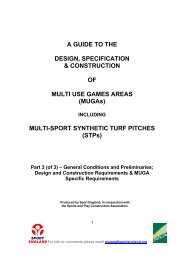View - North East Lincolnshire Council
View - North East Lincolnshire Council
View - North East Lincolnshire Council
You also want an ePaper? Increase the reach of your titles
YUMPU automatically turns print PDFs into web optimized ePapers that Google loves.
BOC Immingham Dissolved Acetylene Project Environmental Statement: Vol. 2 Main Text<br />
� ‘addressing flood risk by adopting a sequential approach to the identification, and<br />
development of sites in accordance with PPS 25. Essential infrastructure will be permitted to<br />
locate within flood risk zones only where they satisfy the Sequential Test and are designed<br />
and constructed to remain operational and safe in times of flood;<br />
� contributing to appropriate flood defence works where applicable, in accordance with the<br />
Humber Flood Risk Management Plan;<br />
� incorporating appropriate flood mitigation and where necessary flood resilience measures; or<br />
flood warning measures;<br />
� incorporating sustainable drainage systems; and where appropriate, green infrastructure;<br />
� adopting sustainable building techniques (including selection and sourcing of materials) that<br />
promote water and energy efficiency and minimise waste through reduction and reuse; both<br />
during the construction and lifetime of the development;<br />
� adopting sustainable design principles regarding the layout and form of development;<br />
� ensuring consideration is given to the effect of development on biodiversity and its capacity to<br />
adapt to likely changes in the climate;<br />
� supporting renewable energy proposals that contribute to meeting the renewable energy<br />
targets for <strong>North</strong> <strong>East</strong> <strong>Lincolnshire</strong> set out in the RSS (50MW by 2021). Renewable energy<br />
development will need to be achieved in ways that maintain the integrity of internationally<br />
important biodiversity resources along the Humber Estuary; and<br />
� development of more than 10 dwellings or 1,000 m 2 of non-residential floorspace, will as a<br />
minimum, be required to source 10% of their energy requirements from on site renewable or<br />
low-carbon energy sources unless it is demonstrated to be not feasible or not viable.’<br />
4.13 Policy GEN 1: Development Areas of the Adopted Local Plan established the principle of<br />
development on the proposed site as it falls within the development area (as defined on the<br />
Proposals Map). Policy E1: Industrial Land indicates that the Site is zoned for B1, B2 and B8 land<br />
uses, thus establishing the principle of using the site for the land use proposed.<br />
4.14 Policy E2: Estuary Land identifies the site as E2/3 Land west of Hobson Way, Stallingborough<br />
(Site A 20.6 ha), (Site B 9.8 ha), (Site C 31.1 ha) and limits development on the Site to that for<br />
which there is a requirement to ‘take advantage of the site’s special estuarial potential or to<br />
ancillary activities with close operational links to existing estuarial related uses’. Policy GEN1<br />
states that proposals must be suitable in relation to the following factors (described more fully in<br />
other Local Plan policies), with:<br />
� ‘their size, scale, density and impact on the character and appearance of the area and the<br />
relationship to existing land uses;<br />
� access and vehicle generation levels;<br />
� provision for services;<br />
� impact upon neighbouring land uses by reason of noise, disturbance or visual intrusion;<br />
� advice from the Health and Safety Executive;<br />
� flood risk;<br />
� impact upon areas of natural and historical heritage; and<br />
� the requirements of other appropriate policies in the development plan.’<br />
5100935.404 Environmental Statement August 2011 50




